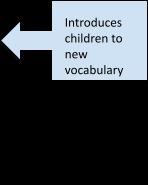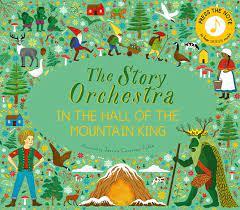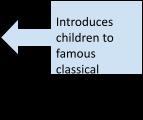Christmas Songs Everyone Big Bear Funk
Key Question: How can we make friends when we sing together?
Key Question: What songs can we sing to help us through the day?
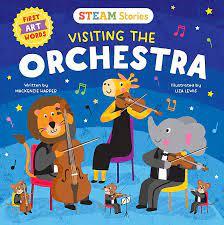
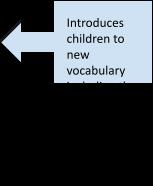
How does music help us to understand our neighbours?
How does music tell stories about the past?

Listening and Respond
Key Question: How does music teacher us about looking after our planet?
How does music make the world a better place?



Knowledge
● To know twenty nursery rhymes off by heart.
● To know the stories of some of the nursery rhymes.
Skills
● To learn that music can touch your feelings.
● To enjoy moving to music by dancing, marching, being animals or Pop stars.
Explore and Create Knowledge
● To know that we can move with the pulse of the music.
● To know that the words of songs can tell stories and paint pictures.
Skills
● Find the pulse by copying a character in a nursery rhyme and finding different ways to keep the pulse.
● Copy basic rhythm patterns of single words, building to short phrases from the song/s.
● Explore high and low using voices and sounds of characters in the songs.
● Listen to high-pitched and low-pitched sounds on a glockenspiel.
● Invent a pattern using one pitched note, keep the pulse throughout with a single note and begin to create simple 2-note patterns to accompany the song.
● Adding a 2-note melody to the rhythm of the words.
● Playing with two pitched notes to invent musical patterns.
Singing Knowledge
● To sing or rap nursery rhymes and simple songs from memory.
● To know songs have sections.
Skills
● To sing along with a pre-recorded song and add actions.
● To sing along with the backing track.
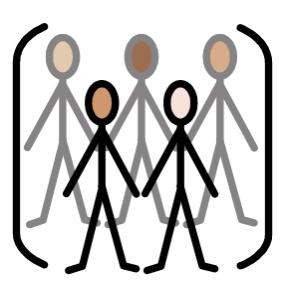
Links to EY Curriculum
CL & EAD
Knowledge
● To know a performance is sharing music.
Skills
● Perform any of the nursery rhymes by singing and adding actions or dance.
● Perform any nursery rhymes or songs adding a simple instrumental part.
● Record the performance to talk about.
Nursery
● Sing a large repertoire of songs.
● Develop their pronunciation
● Use longer sentences of four to six words.

● Be able to express a point of view and to debate when they disagree with an adult or a friend, using words as well as actions.
● Remember and sing entire songs.
● Sing the pitch of a tone sung by another person (‘pitch match’).
● Sing the melodic shape (moving melody, such as up and down, down and up) of familiar songs.
● Create their own songs or improvise a song around one they know
Reception
● Understand how to listen carefully and why listening is important.
● Learn new vocabulary
● Articulate their ideas and thoughts in well-formed sentences.
● Listen carefully to rhymes and songs, paying attention to how they sound.
● Learn rhymes, poems and songs.
● Listen attentively, move to and talk about music, expressing their feelings and responses.
● Sing in a group or on their own, increasingly matching the pitch and following the melody
● Explore and engage in music making and dance, performing solo or in groups

ELG- Listen attentively and respond to what they hear with relevant questions, comments and actions when being read to and during whole class discussions and small group interactions. Make comments about what they have heard and ask questions to clarify their understanding. Participate in small group, class and one-to-one discussions, offering their own ideas, using recently introduced vocabulary. Express their ideas and feelings about their experiences using full sentences.
ELG- Sing a range of well-known nursery rhymes and songs. Perform songs, rhymes, poems and stories with others, and (when appropriate) try to move in time with music.

Enrichment
● Christmas Nativity
● Graduation

Share and Perform
Year One AUTUMN TERM Number (3wks) Ourselves (3 wks) SPRING TERM Animals (3wks) Pattern (3wks) SUMMER TERM Seasons (3 wks) Storytime (3 wks) Focus Beat/Exploring Sounds Pitch/Beat Pitch/Exploring Sounds
● The children explore ways of using their voices expressively. They develop skills of singing while performing actions, and create an expressive story
● The children develop a sense of steady beat through using movement, body percussion and instruments.
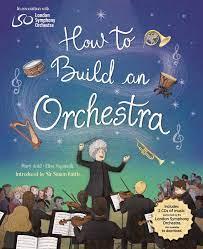
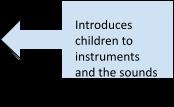
Expression Making your feelings known to others.
Chant A repeated rhythmic phrase
● The children develop an understanding of pitch through using movement, voices and instruments. They identify contrasts of high and low pitches, and create animal chant sounds and sequences.
● The children develop an understanding of metre –groups of steady beat – through counting, body percussion and readying scores.


Expression Making your feelings known to others.
Chant
Prior Learning/ELG
● Sing a range of well-known nursery rhymes and songs.
A repeated rhythmic phrase
● Perform songs, rhymes, poems and stories with others, and (when appropriate) try to move in time with music.
Pupils should be taught to:
Links to National Curriculum
Singing
Playing Instruments
● use their voices expressively and creatively by singing songs and speaking chants and rhymes
● play tuned and untuned instruments musically
● listen with concentration and understanding to a range of high-quality live and recorded music
● experiment with, create, select and combine sounds using the interrelated dimensions of music
● Sing a song with contrasting high and low melodies
● Control vocal dynamics, duration and timbre
● Sing a song together as a group

● Combine voices and movement to perform a chant and a song
● Use voices to create descriptive sounds
● Identify and keep a steady beat using instruments
● Explore and control dynamics, duration, and timbre with instruments
● Play percussion instruments at different speeds (tempi)
● Play and control changes in tempo
● Explore sounds on instruments and find different ways to vary their sound
● Use instruments to create descriptive sounds
● Play fast, slow, loud, and quiet sounds on percussion instruments
● The children develop further their vocabulary and understanding of pitch movements, exploring pitch through singing, tuned percussion and listening games.
● The children learn how music can be used to tell a story They identify contrasts of fast and slow, loud and quiet, leading to a performance.


Expression Making your feelings known to others.
Chant A repeated rhythmic phrase
Overview
Improvising/
Exploring
Composing
● Improvise descriptive music
● Respond to music through movement
● Create a soundscape using instruments
● Explore different sound sources and materials
● Explore sounds on instruments and find different ways to vary their sound
● Invent and perform new rhythms to a steady beat
● Create, play and combine simple word rhythms
● Create a picture in sound
Listening
● Recognise and respond to changes in tempo in music
● Identify changes in pitch and respond to them with movement
● Understand how music can tell a story
● Understand musical structure by listening and responding through movement
Appraising
● Identify a sequence of sounds (structure) in a piece of music
● Listen in detail to a piece of orchestral music (e.g. identify instruments)
● Identify metre by recognising its pattern
● Identify a repeated rhythm pattern
Enrichment Christmas Nativity


Year Two AUTUMN TERM
Storytime (3 wks)
Animals (3 wks)
SPRING TERM
Travel (3 wks)
Season (3 wks)

SUMMER TERM
Number (3 wks)
Our Land (3 wks) Focus
Exploring Sound/Pitch Performance/Pitch
Overview
● The children are introduced to famous pieces to stimulate composition. The children interpret a storyboard with sound effects, and develop their own ideas using voices and percussion.
● The children link animal movement with pitch movement to help develop understanding and recognition of changing pitch. They interpret pitch line notation using voices and tuned instruments.

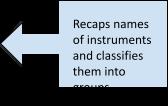
● The children learn a Tanzanian game song and accompany a travelling song using voices and instruments. They listen to an orchestral piece and improvise their own descriptive ‘theme park’ music.
● The children develop understanding of pitch through movement, songs and listening games. They become familiar with pitch shapes and perform them in a variety of musical arrangements.


Beat/Exploring Sounds
● The children explore steady beat and rhythm patterns. They play beats and patterns from Renaissance Italy to West Africa and create their own body percussion, voices and instruments.
● The children explore timbre and texture as they explore descriptive sounds. They listen to, and perform, music inspired by myths.


Chant A repeated rhythmic phrase
Chant A repeated rhythmic phrase
Chant A repeated rhythmic phrase
Prior Learning
Links to National Curriculum
Pupils should be taught to:
● use their voices expressively and creatively by singing songs and speaking chants and rhymes
● play tuned and untuned instruments musically
● listen with concentration and understanding to a range of high-quality live and recorded music
● experiment with, create, select and combine sounds using the interrelated dimensions of music
Expression Making your feelings known to others.
Expression Making your feelings known to others.
Expression Making your feelings known to others.
Beat, Exploring Sounds and Pitch

Singing
● Chant and sing in two parts while playing a steady beat
● Sing with expression, paying attention to the pitch shape of the melody
● Understand pitch through singing, movement, and note names
● Prepare and improve a performance using movement, voice and percussion

Playing Instruments
● Listen to and repeat rhythmic patterns on body percussion and instruments
● Play pitch lines on tuned percussion
● Accompany a song with vocal, body percussion and instrumenta ostinati
● Use instruments expressively in response to visual stimuli
Improvising/Explori
ng
Composing
Listening
● Explore timbre and texture to understand how sounds can be descriptive
● Combine sounds to create a musical effect in response to visual stimuli
● Explore voices to create descriptive musical effects
● Explore different ways to organise music
● Compose music to illustrate a story
● Perform and create simple three- and four-beat rhythms using a simple score
● Match descriptive sounds to images
● Listen to and repeat back rhythmic patterns on instruments and body percussion
Appraising
● Identify ways of producing sounds (e.g. shake, strike, pluck)
● Identify rising and falling pitch
● Listen in detail to a piece of orchestral music (e.g. identify how it depicts a season)
● Use simple musical vocabulary to describe music
● Listen, describe and respond to contemporary orchestral music

Enrichment
● Christmas Nativity



Year Three
AUTUMN TERM
In the Past (3 wks)
Communication (3wks)
SPRING TERM
Building (3 wks)
Poetry (3 wks)
SUMMER TERM
Environment (3 wks)
Singing French ( 3 wks)

● The origins of pitch notations are introduced as the children make hand signals and compose three-note melodies They learn basic dance steps and prepare a performance.
● The children learn to make music inspired by technology and computing. They explore and compose sounds for earcons, emoticons, mobile phone ringtones, computer games and apps
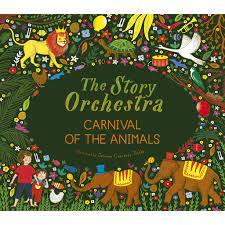
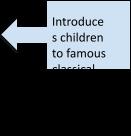
● The sights and sounds of a building site provide the inspiration for exploring and creating rhythms. The children play games, sing and compose music to build into a performance.
● Three contrasting poems are explored and developed The children use voices, body percussion, instruments and movement to create their own expressive performances
● The children explore songs and poems about places They create accompaniments and sound pictures to reflect sounds in their local environment.
● Un, deux, trois and away we go to e enhance language learning through songs. Children are introduced to French greetings, vocabulary and numbers as they play lively singing games
Focus Pitch/Composition Beat/Performance Composition/Pitch
Overview


Solo Done by one person alone
Fluent Express yourself easily
Expression An action which makes your feelings known
Compose To create or make up something
Musical Notation Representing music
Improvise Create and perform without preparation

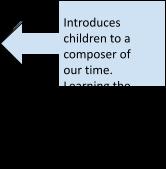




Solo Done by one person alone
Fluent Express yourself easily
Expression An action which makes your feelings known
Compose To create or make up something
Musical Notation Representing music
Improvise Create and perform without preparation.
Solo Done by one person alone
Fluent Express yourself easily
Expression
Prior Learning
Links to National Curriculum
Exploring Sounds, Pitch, Performance, Beat
Singing
An action which makes your feelings known
Compose To create or make up something
Mus otation Representing music

Improvise Create and perform without preparation.
Pupils should be taught to sing and play musically with increasing confidence and control. They should develop an understanding of musical composition, organising and manipulating ideas within musical structures and reproducing sounds from aural memory
Pupils should be taught to:
● play and perform in solo and ensemble contexts, using their voices and playing musical instruments with increasing accuracy, fluency, control and expression
● improvise and compose music for a range of purposes using the interrelated dimensions of music
● listen with attention to detail and recall sounds with increasing aural memory
● use and understand staff and other musical notations
● appreciate and understand a wide range of high-quality live and recorded music drawn from different traditions and from great composers and musicians
● develop an understanding of the history of music
● Sing in two-part harmony
● Copy and create a wide range of vocal sounds to incorporate into a song


Playing Instruments
Improvising/Explori
ng
● Sing in two parts (two different melodies) with movements and percussion
● Perform a round in three parts
● Accompany a song with a melodic ostinato on tuned percussion
● Perform a pentatonic song with tuned and untuned accompaniment
● Play independent parts in more than one metre simultaneously on body percussion, untuned and tuned percussion
● Perform rhythmic ostinati individually and in combination
● Understand and use pitch notations
● Read simple rhythm notation
● Create and perform from a symbol score
● Read graphic notation to play a melody on tuned instruments
● Improvise descriptive music
● Improvise to an ostinato accompaniment
● Explore simple accompaniments using beat and rhythm patterns

Composing
● Select descriptive sounds to accompany a poem
● Choose different timbres to make an accompaniment
● Make choices about musical structure
● Create and perform from a symbol score

● Arrange an accompaniment with attention to balance and musical effect
● Use a score and combine sounds to create different musical textures
Listening
● Listen to and learn about Hindustani classical music
● Learn how sounds are produced and how instruments are classified
● Listen to and learn about traditional Chinese music
● Listen to and learn about a Romantic piece of music
● Listen to and learn about a medieval antiphon
● Listen to, learn about, play and dance to Tudor dance music

Appraising
● Identify the metre in a piece of music
● Recognise rhythm patterns in staff notation
● Recognise pitch shapes
Enrichment Carol Service Year 3 play – Spring Term



Year Four
AUTUMN TERM
Drumming – Lancashire Music Service
Overview Playing Instruments / Listening
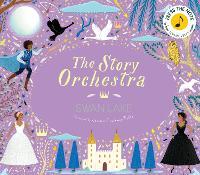

Solo Done by one person alone
Fluent Express yourself easily
Expression An action which makes your feelings known.
Compose To create or make up something
Musical Notation Representing music
Improvise
Create and perform without preparation
SPRING TERM
Drumming – Lancashire Music Service
Improvising and Exploring / Composing
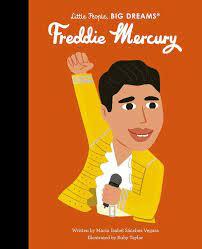


SUMMER TERM
Drumming – Lancashire Music Service
Singing/ Appraising

Solo Done by one person alone
Fluent
Express yourself easily
Expression An action which makes your feelings known
Compose To create or make up something
Musical Notation Representing music
Improvise
Create and perform without preparation.



Solo Done by one person alone
Fluent
Express yourself easily
Expression An action which makes your feelings known
Compose To create or make up something
Musical Notation Representing music
Improvise Create and perform without preparation.

Year Five AUTUMN TERM
Solar System (6 wks)
Focus

SPRING TERM
Life Cycles (6 wks)
SUMMER TERM
At the Movies (6 wks)
Listening Structure Composition
Overview Embark on a musical journey through the solar system, exploring how our universe inspired composers including Claude Debussy, Gustav Holst and George Crumb. The children learn a song, and compose pieces linked to space.
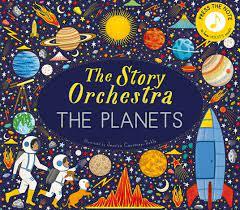

Solo Done by one person alone
Fluent
Express yourself easily
Expression An action which makes your feelings known
Compose
To create or make up something
Musical Notation Representing music
Improvise
Create and perform without preparation
Explore the human life cycle with music by Johannes Brahms, Luciano Berio, Franz Liszt and Claudio Monteverdi. The wide variety of musical moods, styles and genres inspires singing, performing and composing using new techniques and structures.
Explore music from 1920s animated films to present day movies. The children learn techniques for creating soundtracks and film scores, and they compose their own movie music.
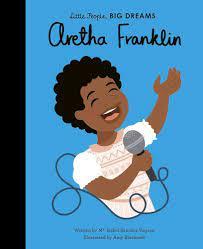
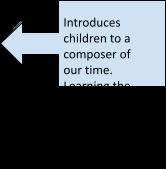


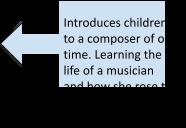

Solo Done by one person alone
Fluent Express yourself easily
Solo Done by one person alone
Fluent
Express yourself easily
Expression An action which makes your feelings known
Compose
To create or make up something
Musical Notation Representing music
Improvise Create and perform without preparation
Expression An action which makes your feelings known
Compose To create or make up something
Musical Notation Representing music
Improvise Create and perform without preparation.

Wider Opportunities – Samba Drumming Rhythm/ Improvising/Composing
Links to National Curriculum

Pupils should be taught to sing and play musically with increasing confidence and control. They should develop an understanding of musical composition, organising and manipulating ideas within musical structures and reproducing sounds from aural memory Pupils should be taught to:
● play and perform in solo and ensemble contexts, using their voices and playing musical instruments with increasing accuracy, fluency, control and expression
● improvise and compose music for a range of purposes using the interrelated dimensions of music
● listen with attention to detail and recall sounds with increasing aural memory
● use and understand staff and other musical notations
● appreciate and understand a wide range of high-quality live and recorded music drawn from different traditions and from great composers and musicians
● develop an understanding of the history of music
Singing
● Prepare for a performance by considering narration, performance space, setting up and other logistics
● Develop techniques of performing rap using texture and rhythm
● Sing and play scales and chromatic melodies accurately
● Sing and play percussion in a group piece with changes in tempo and dynamics
● Sing a song in unison and three-part harmony
● Sing with attention to accuracy in rhythm, pitch and dynamics

Playing Instruments
● Read a melody in staff notation
● Interpret graphic notation on various soundmakers with an understanding of their qualities and capabilities
● Perform music together in synchronisation with a short movie
● Develop ensemble playing, focusing on steady beat and placing notes accurately together
● Control short, loud sounds on a variety of instruments

Improvising/Explori ng
● Develop accompaniments using ostinato and invent or improvise rhythms on untuned percussion
● Learn about jazz scat singing and devise scat sounds
● Play and improvise using the whole tone scale
● Create musical effects using contrasting pitch
● Interpret graphic notation on various soundmakers with an understanding of their qualities and capabilities
● Learn about and explore techniques used in movie soundtracks

Composing
● Develop a structure for a vocal piece and create graphic scores
● Explore extended vocal techniques through listening to and composing ‘a capella’ (unaccompanied) vocal music based on graphic scores
● Use the musical dimensions to create and perform music for a movie
● Evaluate and refine compositions with reference to the inter-related dimensions of music
● Create sounds for a movie, following a timesheet

Listening
● Hear and understand the features of the whole tone scale
● Listen to and learn about modern classical/avant garde music (20th century)
● Learn about the music of an early Baroque opera
● Demonstrate understanding of the effect of music in movies
Prior
Learning

Appraising
● Listen to a 19th century tone poem and describe its effects and use of the musical dimensions
● Listen to and analyse 19th century impressionist music using musical vocabulary
● Compare and contrast two pieces of 19th century Romantic music
● Identify changes in tempo and their effects
● Evaluate and refine compositions with reference to the inter-related dimensions of music
● Explore and analyse a song arrangement and its structure
● Rehearse, improve and analyse an ensemble performance, with attention to balance and staying in time

Enrichment
● Carol Concert
● Year 5 Play









